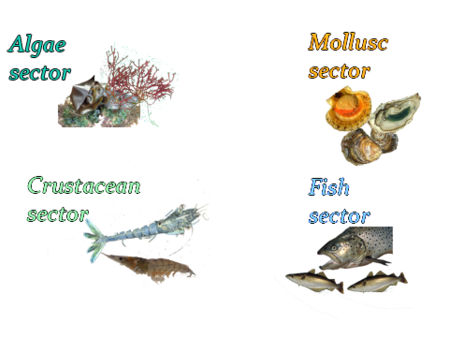European seabass
Name : | European seabass |
|---|---|
Scientific name : | Dicentrarchus labrax, from the Moronidae family. |
Size : | the maximum size of a common bass can reach 100 cm in length and 10 kg to 12 Kg in weight. |
History : from the pioneers to present…
The bass belongs to a few ‘’pioneer’’ species of marine fish farming. The first larval rearing tests started in France in the seventies. The rearing technique used today was developed – broadly – in the eighties. To summarize, the steps were as follows:
- first, captive egg-laying and identification of problems specific to larval rearing and to the feed transition from live preys to granulates (weaning)
- removal of rotifiers (Brachionus plicatilis) from the larvae feed and shift to a first feeding process exclusively based on small crustaceans (Nauplius of Artemia)
- solving of the problem of ‘’non inflation’’ of the swim blabber
- development of weaning and fattening feed suited to the species
- development of a compound feed usable for larvae as a total replacement of Artemia
- control of the artificial reproduction enabling controlled crossings
- genetical improvement of the species and control of the sex determinism.
Rearing techniques and production cycle
Of all farmed marine species bass farming is probably the best mastered technique. The bass is a "gonochoric" species in which individuals are male or female.
The females, which grow more than the males, reach their sexual maturity at 3 years of age, and they can lay egg spontaneously in captivity. By modifying the rearing temperature and the duration of the day, it is possible to make them lay eggs several times throughout the year.
Each laying comprises thousands of eggs (diameter 1.2 mm).
At hatching, the larvae are blind and their mouth is not yet open.
To ensure that larvae growth is normal, rearing starts in total obscurity without any food. Light is only turned on as of about day 10, when the swim bladder of the larvae inflates with air.
Since the bass larva is sufficiently large, feeding can be done directly with Nauplius of Artemia or, recently, using micro-granulates especially developed for this species.
Growout takes place either inside inland ponds (North of France, Languedoc) or inside floating cages (South-East of France). The "portion" size is reached after two years of farming at ambient temperature in the Mediterranean sea, although growth can be accelerated by heating up the water of the farming ponds.
Sea bass yields evolution
Bass farming production experienced a very fast and very recent growth in Europe. Whereas there was no production in 1980, more than 50,000 tons had been produced as early as 2000. Although France, where the techniques have been developed, has a modest production of commercial size fish, the alevins from French hatcheries are exported all over Europe.
Source FAO 2008 data 2006
Product value enhancement
The bass is sold as a whole fresh fish. Most of the production targets "portion" size fish of about 300 to 500 g.
This fish cannot be filleted (the "bass fillets" sold frozen are almost always produced from the Anarhichas lupus, a very different family of species fished in the North Sea, and with a lower commercial value).
Sea bass figures
8 000 | bass consumption in tons per year for the whole French population. This consumption doubled between 1995 and 2000. |
|---|---|
55 | percentage of farmed bass consumed versus total bass consumption in France, the rest being fished. |
50 000 | bass tonnage produced in the Mediterranean in 2000. |
Strengths / Weaknesses
Strengths | Weaknesses |
|---|---|
|
|

